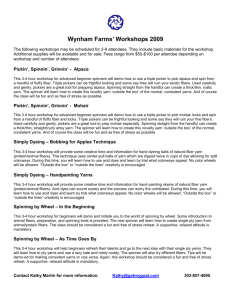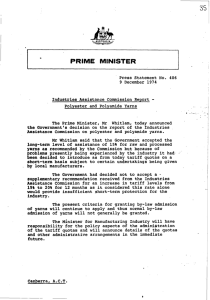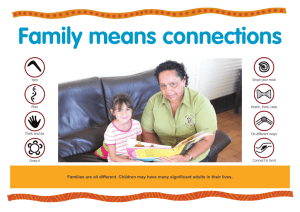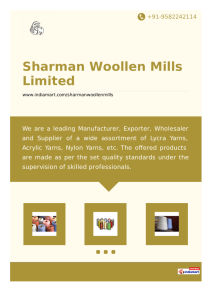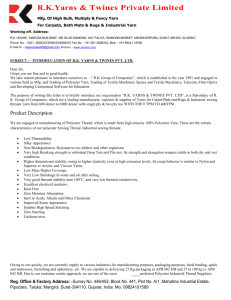Comparison of the Properties of a Cotton and Open-End Rotor Yarns
advertisement
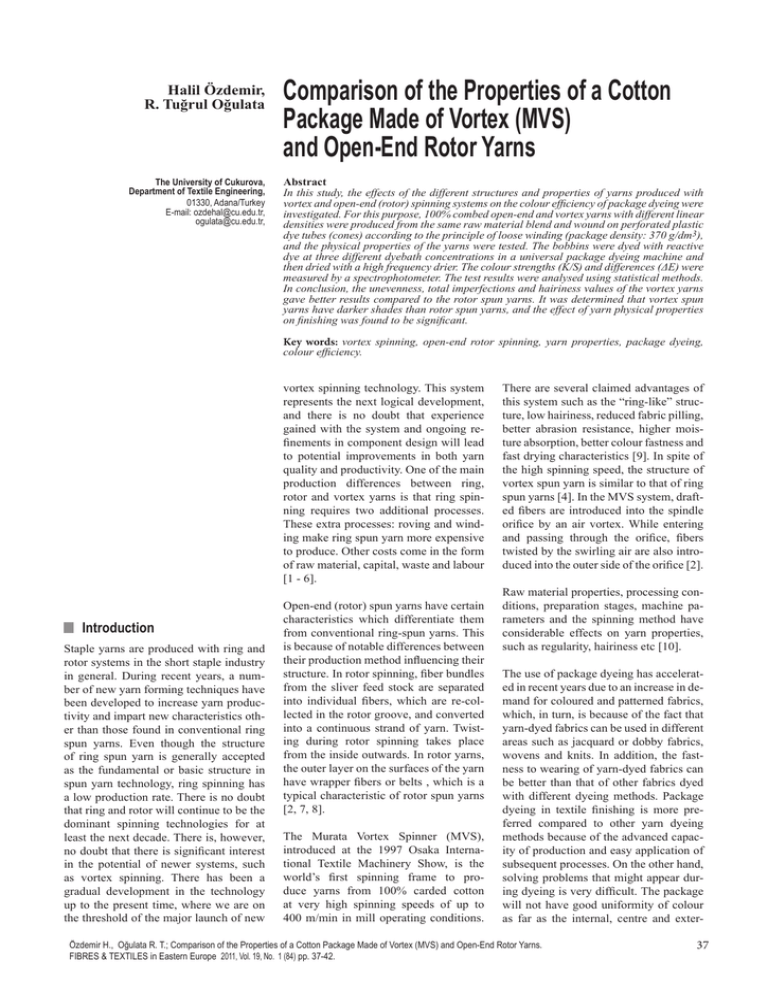
Halil Özdemir, R. Tuğrul Oğulata The University of Cukurova, Department of Textile Engineering, 01330, Adana/Turkey E-mail: ozdehal@cu.edu.tr, ogulata@cu.edu.tr, Comparison of the Properties of a Cotton Package Made of Vortex (MVS) and Open-End Rotor Yarns Abstract In this study, the effects of the different structures and properties of yarns produced with vortex and open-end (rotor) spinning systems on the colour efficiency of package dyeing were investigated. For this purpose, 100% combed open-end and vortex yarns with different linear densities were produced from the same raw material blend and wound on perforated plastic dye tubes (cones) according to the principle of loose winding (package density: 370 g/dm3), and the physical properties of the yarns were tested. The bobbins were dyed with reactive dye at three different dyebath concentrations in a universal package dyeing machine and then dried with a high frequency drier. The colour strengths (K/S) and differences (ΔE) were measured by a spectrophotometer. The test results were analysed using statistical methods. In conclusion, the unevenness, total imperfections and hairiness values of the vortex yarns gave better results compared to the rotor spun yarns. It was determined that vortex spun yarns have darker shades than rotor spun yarns, and the effect of yarn physical properties on finishing was found to be significant. Key words: vortex spinning, open-end rotor spinning, yarn properties, package dyeing, colour efficiency. vortex spinning technology. This system represents the next logical development, and there is no doubt that experience gained with the system and ongoing refinements in component design will lead to potential improvements in both yarn quality and productivity. One of the main production differences between ring, rotor and vortex yarns is that ring spinning requires two additional processes. These extra processes: roving and winding make ring spun yarn more expensive to produce. Other costs come in the form of raw material, capital, waste and labour [1 - 6]. n Introduction Staple yarns are produced with ring and rotor systems in the short staple industry in general. During recent years, a number of new yarn forming techniques have been developed to increase yarn productivity and impart new characteristics other than those found in conventional ring spun yarns. Even though the structure of ring spun yarn is generally accepted as the fundamental or basic structure in spun yarn technology, ring spinning has a low production rate. There is no doubt that ring and rotor will continue to be the dominant spinning technologies for at least the next decade. There is, however, no doubt that there is significant interest in the potential of newer systems, such as vortex spinning. There has been a gradual development in the technology up to the present time, where we are on the threshold of the major launch of new Open-end (rotor) spun yarns have certain characteristics which differentiate them from conventional ring-spun yarns. This is because of notable differences between their production method influencing their structure. In rotor spinning, fiber bundles from the sliver feed stock are separated into individual fibers, which are re-collected in the rotor groove, and converted into a continuous strand of yarn. Twisting during rotor spinning takes place from the inside outwards. In rotor yarns, the outer layer on the surfaces of the yarn have wrapper fibers or belts , which is a typical characteristic of rotor spun yarns [2, 7, 8]. The Murata Vortex Spinner (MVS), introduced at the 1997 Osaka International Textile Machinery Show, is the world’s first spinning frame to produce yarns from 100% carded cotton at very high spinning speeds of up to 400 m/min in mill operating conditions. There are several claimed advantages of this system such as the “ring-like” structure, low hairiness, reduced fabric pilling, better abrasion resistance, higher moisture absorption, better colour fastness and fast drying characteristics [9]. In spite of the high spinning speed, the structure of vortex spun yarn is similar to that of ring spun yarns [4]. In the MVS system, drafted fibers are introduced into the spindle orifice by an air vortex. While entering and passing through the orifice, fibers twisted by the swirling air are also introduced into the outer side of the orifice [2]. Raw material properties, processing conditions, preparation stages, machine parameters and the spinning method have considerable effects on yarn properties, such as regularity, hairiness etc [10]. The use of package dyeing has accelerated in recent years due to an increase in demand for coloured and patterned fabrics, which, in turn, is because of the fact that yarn-dyed fabrics can be used in different areas such as jacquard or dobby fabrics, wovens and knits. In addition, the fastness to wearing of yarn-dyed fabrics can be better than that of other fabrics dyed with different dyeing methods. Package dyeing in textile finishing is more preferred compared to other yarn dyeing methods because of the advanced capacity of production and easy application of subsequent processes. On the other hand, solving problems that might appear during dyeing is very difficult. The package will not have good uniformity of colour as far as the internal, centre and exter- Özdemir H., Oğulata R. T.; Comparison of the Properties of a Cotton Package Made of Vortex (MVS) and Open-End Rotor Yarns. FIBRES & TEXTILES in Eastern Europe 2011, Vol. 19, No. 1 (84) pp. 37-42. 37 Table 1. Main fiber properties (HVI and AFIS measurement for raw cotton). Average Value Fiber properties HVI Micronaire 4.1 Mean length of upper half (UHML), mm 30.1 Length uniformity,% 82.9 Strength, G/tex 32.7 Elongation,% 5.64 SFI,% 6.4 Reflectance degree, Rd 80.1 (extra bright) Yellowness, +b 7.6 (white) Colour-Grade, C-G 31-1 (white cotton) AFIS Neps, cnt/gr 146 Seed coat nep (SCN), cnt/gr 23 Short fiber content by weight (SFCw),% 9 Upper quartile length by weight (UQLw),mm 30.6 Maturity ratio (MR) 0.90 Dust, cnt/gr 576 Trash, cnt/gr 57 nal parts of dyed bobbins are concerned because of the deformity of yarn. Nevertheless, levelness and faulty dyeing can occur because of poor yarn properties, insufficient machinery and equipment, wrong selection of yarn dye tubes, a nonuniform package density and winding profile, using the wrong dye, auxiliaries, the process, and the dyer or personnel errors [11 - 15]. The colour uniformity of products is most important in the textile finishing industry. It’s believed that yarn properties such as yarn regularity, hairiness and bulkiness affecting the yarn count and spinning systems are significantly influenced by both the dyeing behaviour and colour values (K/S, L*, C* etc.) [16]. With respect to the spinning method, rotor spun yarns have higher dyeability than ring spun yarns, which is due to the fact that rotor spun yarns are considered to the yield more open structures [17]. There are studies comparing the structure of compact yarn with that of ring spun yarns, the greater evenness of the structure and reduced hairiness of compact yarn being well known [18]. Göktepe and Ceken reported that there is a significant colour difference between fabrics of ring and compact spun yarns: those of compact yarns have darker shades, even though they are dyed in the same bath [19]. In the study by Ozdil et al. knitted double jersey fabrics from 100% combed ring-spun and compact cotton yarns of the same raw material blend were dyed under laboratory conditions with different dyestuffs. Interestingly, the results showed that there was no significant difference in the K/S and Lab values for any of the fabric samples. In the investigation by Kretzschmar et al., 100% cotton yarns produced from the same cotton blend were spun according to compact and ring spinning principles using two different yarn counts and twisting factors. The results show that the colour efficiencies of knitted fabrics produced from compact yarns were found to be slightly higher in comparison with fabrics knitted with ring yarns. However, these differences were statistically unimportant [20]. In this paper, combed cotton package yarns produced by open-end (rotor) and Murata vortex spinning were dyed with a Table 2. Data of process conditions for the cotton spinning. Item No. OERS MVS Ne 30 (19.7 tex) Ne 36 (16.4 tex) 128.3 125.8 116.8 340 340 320 210 238.7 280 140 163 168 Rotor speed, r.p.m 95000 100000 102000 ----- ----- ----- Rotor T231 T533 T231 ----- ----- ----- ----- ----- ----- 9600 9200 9600 ----- ----- ----- ----- ----- ----- Delivery speed, m/min Total draft Ne 26 (22.7 tex) Sliver weight, ktex 4.54 Novel Combing speed, r.p.m Combing roller Ne 26 (22.7 tex) Ne 30 (19.7 tex) Ne 36 (16.4 tex) 3.5 KN4 B174N B174DN B174N Nozzle type ----- ----- ----- 70d/4j Needle holder ----- ----- ----- 2p130dL7 (9.3) Spindle diameter ----- ----- ----- 1.2 Air pressure (bar) ----- ----- ----- 4.5 Gauge ----- ----- ----- 36-36-49/36-36-44.5 38 Table 3. Pre-treatment and dyeing process conditions. Pre-treatment Hydrogen peroxide, g/l 2.2 NaOH, cc/l 2.5 Stabilizer, g/l 0.8 Wetting agent, g/l 1.1 Acetic acid, g/l 0.5 Anti-peroxide enzyme, g/l 0.4 Liquor ratio 1/10 Washing and softening Acetic acid, g/l 0.5 Soap washing I (1.5%, 4%), g/l 0.17 Soap washing II (4%), g/l 0.17 Acetic acid (for pH), g/l 0.6 Softening agent I, g/l 1.2 Softening agent II, g/l 1.6 Reactive dyeing Reactive Blau CA, % 0.2 Reactive Blau CA, % 1.5 Reactive Blau CA, % 4.0 Wetting agent, g/l 1 Salt (0.2%, 1.5%, 4%), g/l 10, 35, 50 Soda, g/l 10 Table 4. Technical properties of the knitting machine. Cylinder diameter, inc 31/2 Speed, r.p.m 400 max. Gauge Knite type 18 Plain knitted fabrics (single jersey) reactive dyestuff in mill conditions. The dyeabilities (color efficiency, lightness and chrome) and colour differences were evaluated and discussed in relation to the spinning method and dyeing. n Experimental study In this study, MVS and OE-rotor yarns were produced with three linear densities (Ne; 26/1, 30/1 and 36/1) and dyed with three dye concentrations (0.2%, 1.5% and 4%). Two replications were carried out for each package in the study. 100% combed cotton yarns were spun from Indian cotton fibers according to the openend (rotor) and Murata vortex spinning methods. So far carded cotton has not been efficiently used in the vortex spinning system . In addition , both spinning systems and processes (carding or combing) are directly affected by the dyeability . Therefore, in the study all yarns were manufactured by combing solely. The fiber properties of the cotton used to produce the yarn are shown in Table 1. The cotton bale was tested on a high volume instrument (HVI; four replications for micronaire, four for colour, and 10 for FIBRES & TEXTILES in Eastern Europe 2011, Vol. 19, No. 1 (84) a) b) Figure 1. a) Pre-treatment, b) Dyeing diagrams. fiber length and strength and on an Advanced Fiber Information System (AFIS; three replications of 3000 fibers each). For all the yarns, the raw cotton fibers were opened, cleaned, carded (Rieter 60) and combed (Rieter E 30). Before the yarn spinning processes, open-end rotor yarns were spun directly from a second passage sliver (I. Rieter SBD 15, II. Rieter RSBD 35), whereas the second passage sliver was subjected to a third drawing (I. Rieter SBD 15, II. Rieter SBD 15, III. Rieter RSBD 35) for MVS yarns. Rotor yarns were produced on a Schlofhorst Autocoro SE 11 OERS yarn machine, and an MVS 851 vortex spinning machine was used to produce vortex yarns. The production of vortex and rotor yarns was achieved with three different yarn counts: 22.7 tex, 19.7 tex, 16.4 tex. All the yarns were spun with a suitable twist factor for knitted fabrics. Data describing the process setting and conditions for the cotton spinning are listed in Table 2. MVS and rotor bobbins with different linear densities were wound to perforated plastic dye tubes (cones) according to the principle of loose winding (package density: 370 gr/L) for soft dye packages under mill conditions. The evenness, imperfection and hairiness properties of the resulting yarns were measured on an Uster Evenness Tester 4, and the yarn tensile properties were tested on an Uster Tensorapid Tester. In addition , yarn hairiness tests were also performed on a Zweigle G566. All these tests were performed under standard conditions (20 °C and 65% relative humidity). After loose winding, the cotton packages were pre-treated and dyed in the same Universal Package Dyeing Machine (Krantz) to eliminate any variations during these processes. Table 3 and Figure 1 show the auxiliaries and dyeing diagrams FIBRES & TEXTILES in Eastern Europe 2011, Vol. 19, No. 1 (84) used in the pre-treatment and dyeing processes. Afterwards, the dyed packages were dehydrated with a centrifugal hydro-extractor (Berta 24 TE, 1550 r.p.m, 6 min) and dried with a high frequency drier (conveyor belt speed: 3,5 m/h). For colour measurements on a spectrophotometer, the dyed yarns were knitted on a laboratory-type sample circular knitting machine (Faycon CKM 01-S). The technical properties of the knitting machine are given in Table 4. The colour coordinates of the dyed packages were measured on a Minolta CM 3600 D model spectrophotometer coupled to a PC, within the range of 400-700 nm under a D65/10o illuminant. Percent reflectance values at the wavelength of maximum absorption (630 nm) were recorded. K/S (colour strength) values were obtained from the Kubelka Munk equation; K/S = (1 - R)2/2R (1) Where K is a constant associated with the light absorption of the fabric, predominantly determined by the dyestuff; S is the constant associated with the light scattering of the fabric, determined only by the textile material, and R is the reflectance of the dyed fabric measured at the wavelength of maximum light absorption. The CIELAB formula is used to assess small colour differences and is recom- mended for use by DIN 6174. The colour difference is determined using a colour difference formula from the colorimetric measures L*, a* & b* which result from the CIE tristimulus values X, Y & Z. The L*-value indicates the position on the light/dark axis in the L*, a*, b* system, the a* - value - the position on the red/green axis, and the b* - value gives the position on the yellow/blue axis [21, 22]. According to DIN 6174, the ΔE*ab colour difference is calculated as follows: ΔE* = [(ΔL*)2+(Δa*)2+(Δb*)2]1/2 (2) Both test results of the yarns spun and the colour measurement of the dyed packages were evaluated and interpreted statistically. SPSS 11.5 for Windows, a statistics program for use on a PC, was used for the statistical analyses (t-tests, correlation and regression analyses etc.). The differences between the groups for which the significance values were less than 0.05 were interpreted as statistically important. n Test results Yarn properties Average values of the yarn properties are given in Table 5. The parameters Um%, thin/thick places and yarn hairiness (S3) values of the vortex yarns were less than the those of the rotor yarns. On the other hand, the tenacity and elongation at break Table 5. Average values of the yarn properties; Neps Rotor; +280%, MVS;+200%. Yarn features OERS MVS Linear denacity, tex 15.9 19.1 21.4 16.5 20.9 23.2 Linear denacity, Ne 37.1 30.9 27.6 35.7 28.2 25.4 8.62 Evenness (Um ),% 13.1 11.9 11.8 9.68 9.14 Thin places, -50% 121.5 50.5 27.5 19.8 6 0 135 66 75 33.5 33.5 9.3 Thick places, +50% 24 9.5 17 105.0 69 20 Elongation at break,% 4.22 5.24 4.85 4.87 5.41 5.36 Neps* Tenacity, r.p.m 11.59 12.01 11.75 15.14 16.85 14.97 H (UT3 hairiness index) 4.71 5.08 5.41 4.19 4.23 5.97 S3 (hairs ≥ 3 mm/100 m) 1321 1542 1776 73 57 464 39 increased. However, there were no significant differences for the elongation at break and tenacity values. n Statistical analysis Figure 2. Comparison of yarn evenness. Figure 3. Comparison of the number of thin places. Tenacity, cN/tex Figure 4. Comparison of the number of thick places. Yarn count, tex Figure 5. Comparison of the tenacity. values were higher for the vortex yarns than for the rotor yarns. As a consequence of these results, it was determined that the vortex yarn had better yarn properties in comparison with the rotor yarns (Figure 2 - 7). The Um%, thin/thick places and neps increased, whereas H and S3 values decreased as the yarn count 40 Results of the analysis of statistics (“t” test and correlation analyses) are reported in Tables 6 - 7. Table 6 reveals that there were significant differences with respect to evenness, cN/tex (tenacity) and S3 (hairiness) values for the two different spinning systems. However, the effect of the spinning system on yarn imperfections (thin/ thick places and neps) was insignificant. In addition, Table 7 reveals that the effect of the linear density on yarn properties was insignificant for the three different counts (22.7, 19.7 and 16.4), whereas yarn evenness significantly affected thin and thick places, rkm and S3 values. Comparison of the colour from each system We measured the K/S and Lab values of fabric samples knitted from rotor and vortex yarns, which were dyed under mill conditions with different dye concentrations. We also wanted to compare how the colour shades (K/S, colour efficiency) of the spinning system and yarn count change. Figures 8 and 9 show the test results. The color efficiencies of the fabric knitted with vortex yarns were higher than those of the fabric knitted with rotor yarns. The results reveal that vortex yarns have darker shades compared to rotor yarns. Results of the statistical analysis are given in Table 8. The Table 8 reveals that the difference between the K/S values was found to be statistically important at a 1.5% (owf) dye concentration, whereas it was unimportant at the other dye concentrations. In addition, the lightness values (L*) were also found to be statistically important at dye concentrations of 1.5% and 4%. However, there were no significantly differences with respect to the slight shade (0.2%) when the two spinning systems were compared to each other. Eventually, vortex yarns can be dyed darker shades and rotor yarns can be lighter at medium and high dye concentrations. The relationship between the spinning systems, yarn counts and colour difference values is shown in Figures 10 and 11. We took a dyed fabric sample consisting of rotor spun yarns as the reference sample. Colour difference (ΔE*) Figure 6. Comparison of the elongation. Figure 7. Comparison of the hairiness, S3. values greater than 1.0 indicate a significant colour difference compared to the reference sample. Figure 10 indicates that there are not usually significant colour differences between the three yarn counts. However, Figure 11 indicates that there are significant colour differences between the two spinning systems, whereas there are rarely significant coTable 6. Paired sample test of yarns produced. Open-end rotorMurata Vortex Paired sample test Sign. (2-tailed) U m% 0.004 Thin 0.123 Thick 0.079 Neps 0.176 Elongation at break,% 0.09 Breaking tenacity, Rkm 0.016 S3 0.003 Table 8. Paired sample test of dyed samples; Compared systems: Rotor-Vortex, * significant at α = 0.05, ** significant at α = 0.01. Dye concentration, % Sign. (2-tailed) K/S L 0.2 0.089 0.08 1.5 0.005** 0.005** 4.0 0.052 0.037* FIBRES & TEXTILES in Eastern Europe 2011, Vol. 19, No. 1 (84) Table 7. Correlation analysis of yarns produced; ** Correlation is significant at a level of 0.01 (2-tailed), * Correlation is significant at a level of 0.05 (2-tailed). Linear density Um Thin Thick Neps Elong. Rkm S3 1.000 0.300 0.583 0.439 0.543 -0.622 -0.028 -0.237 Pearson Correlation 0.563 0.225 0.383 0.266 0.188 0.957 0.651 1.000 0.871(*) 0.945(**) 0.499 -0.745 -0.912(*) 0.842(*) 0.035 Sig. (2-tailed) 0.563 0.000 0.024 0.004 0.313 0.089 0.011 Pearson Correlation -0.237 0.842(*) 0.539 0.674 0.798 -0.409 0.948(**) 1.000 Sig. (2-tailed) 0.651 0.035 0.270 0.142 0.057 0.420 0.004 0.000 60 O.E. Rotor 50 8 4 30 20 10 16.4 - 0.2% 22.7 - 4.0% 19.7 - 4.0% 16.4 - 4.0% 22.7-1,5% 16.4-1,5% 22.7 - 0.2% 16.4 - 0.2% 19.7-1,5% 0 0 Yarn count, tex - Dye concentration, % Yarn count, tex - Dye concentration, % Figure 9. Effect of the linear density and spinning system on the Lightness (L*) value. 1.8 1.2 1.6 Colour difference difference (DE) Copour (DE) 1.4 1 0.8 0.6 0.4 0.2 1.4 1.2 1 0.8 0.6 0.4 count, tex - Dye concentration, % YarnYarn count, tex - Dye concentration, % Figure 10. Change in the colour difference value for the same spinning system when the yarn count and dye concentration are increased. 0.2% Rotor-Vor tex (16.4) Rotor -Vortex ( 22.7) Rotor- Vortex ( 16.4) Rotor-Vortex (19.7) Rotor-Vortex (19.7) 4.0% Figure 11. Change in the colour difference value for different spinning systems when the yarn count and dye concentration are increased. Besides this MVS yarns are bulkier than rotor yarns [2]. n Conclusions The aim of this study was to analyse the effects of the spinning system and linear density on package dyeing. FIBRES & TEXTILES in Eastern Europe 2011, Vol. 19, No. 1 (84) 1.5% system, count, tex- -Dye Dye concentration, % % SpinningSpinning system, YarnYarn count, tex concentration, lour differences at various yarn counts for the same spinning system. MVS yarn is mainly composed of core and wrapper fibers, whereas OERS yarn is composed of core fibers, which are generally highly parallel. Therefore, MVS spun yarns have better evenness and hairiness than rotor spun yarns, the reason being that MVS core fibers, which are highly oriented in parallel, have almost no twist and more than half of the surface area of MVS yarns is covered and packed by a layer of wrapper fibers. Rotor-Vortex (22.7) 19.7/16.4 22.7/16.4 4.0% Rotor-Vortex (16.4) 1.5% MVS Vortex 22.7/19.7 19.7/16.4 22.7/16.4 22.7/19.7 19.7/16.4 22.7/16.4 0.2% Rotor -Vortex ( 19,7) 4.0% 22.7/19.7 19.7/16.4 22.7/16.4 22.7/19.7 19.7/16.4 22.7/16.4 1.5% O.E. Rotor 0 Rotor-Vortex (22.7) 0.2% 22.7/19.7 19.7/16.4 22.7/16.4 0.2 22.7/19.7 Copour (DE) Colourdifference difference (DE) Figure 8. Effect of the linear density and spinning system on the K/S value. 0 22.7 - 4.0% 12 40 19.7 - 4.0% 16 MVS Vortex 22.7-1,5% Lightness (L*) 20 16.4 - 4.0% MVS Vortex 19.7-1,5% O.E. Rotor 24 19.7 - 0.2% Colour efficiency (K/S) 28 16.4-1,5% S3 , 0.300 22.7 - 0.2% Um Sig. (2-tailed) Pearson Correlation 19.7 - 0.2% Linear density In this study, with regard to evenness, total imperfection and hairiness values, vortex yarn was better than rotor spun yarn. Statistically, hairiness and evenness were the most important properties of the yarns, which were produced using two different spinning systems. The K/S (colour efficiency) and ΔE* (color difference) results indicate that vortex spun yarns have darker shades than rotor spun yarns even though they were dyed in the same bath. This difference might be because of the more even yarn structure and less hairiness values of vortex yarn. These results indicate that the hairiness of yarn and the yarn surface regularity should be considered for dyed fabrics independently, because of the fact that the surface characteristic has an effect on reflectance values after dyeing. References 1. Huh Y., Kim Y. R., Oxenham W.; Textile Research Journal, Vol. 72, Issue 2, 2004, pp. 156-165. 41 2. Soe A. K., Takahashi M., Nakajima M., at al.; Textile Research Journal, Vol. 74, Issue 9, 2004, pp. 815-826. 3. Oxenham W.; “Current and Future Trends in Yarn Production”, 2002, JTATM, Vol. 2, Issue 2, Spring, pp. 1-10. 4. Örtlek H. G., Şener M., Ülkü S.; Tekstil Teknoloji (International Textile Technology Magazine), August, Vol. 9, Issue 98, 2004, pp. 82-93. 5. Oxenham W.; JTATM, Winter, Vol.1, Issue 2, 2004, pp. 1-7. 6. Dodd E., Oxenham W.; JTATM, Summer, Vol. 2, Issue 3, 2002, pp. 1-8. 7. Koç E., Lawrance C.A., Iype C.; Fibres & Textiles in Eastern Europe, April/June, Vol. 13, Issue 2, 2005, pp. 8-15. 8. Örtlek H. G., Ülkü S.; “The Comparison of The Properties of Murata Vortex-Ringand Rotor Spun Cotton Yarns”, 2005, 5th International Istanbul Textile Conference Papers, İstanbul. 9. Basal G., Oxenham W.; Textile Research Journal, Vol. 76, Issue 6, 2006, pp. 492-499. 10. Üreyen M. E., Kadoğlu H.; Textile Research Journal, Vol. 76, Issue 5, 2006, pp. 360-366. 11. Park J.; “Introduction, A Practical Introduction to Yarn Dyeing”, The Society of Dyers and Colorist, UK,1981, pp.1-8. 12. AATCC Symposium, “Yarn Dyeing ’97: Insight For Today, A Vision For The Future”, 1997, Textile Chemist and Colorist, Vol. 29, Issue 9, pp. 9-13. 13. Chakraborty M., Sharma, D. K., “Technological Developments in Yarn Processing”, 1998, Colourage, May, pp. 19-22. 14. AATCC Symposium, “Yarn Dyeing: Problems and Solutions”, 1990, Textile Chemist and Colorist, June, Vol. 22, Issue 6, pp. 26-28. 15. Yang Y., Mattison V., L.; Textile Chemist and Colorist, Vol. 29, Issue 8, 1997, pp. 77-81. 16. Becerir B., Ömeroglu S.; AATCC Review, July, Vol. 7, Issue 7, 2007, pp. 41-46. 17. Micheal M. N., Dyab W. A.; AATCC Review, March, Vol. 1, Issue 3, 2001, pp. 53-56. 18. Göktepe F., Yılmaz D., Göktepe O.; Textile Research Journal, Vol. 76, Issue 3, 2006, pp. 226-234. 19. Çeken F., Göktepe F.; Fibres & Textiles in Eastern Europe, January/March, Vol. 13, Issue 1 (49) 2005, pp. 47-50. 20. Kretzschmar S. at al.; Textile Research Journal, Vol. 77, Issue 4, 2007, pp. 233-241. 21. İskender M. A., Becerir B., Koruyucu A.; Textile Research Journal, Vol. 75, Issue 6, 2005, pp. 462-465. 22. Rouette H. K., “Encyclopedia of Textile Finishing”, Woodhead Publishing, 2001, pp. 130-140. Received 02.07.2008 42 INSTITUTE OF BIOPOLYMERS AND CHEMICAL FIBRES LABORATORY OF PAPER QUALITY Since 02.07.1996 the Laboratory has had the accreditation certificate of the Polish Centre for Accreditation No AB 065. The accreditation includes tests of more than 70 properAB 065 ties and factors carried out for: npulps n tissue, paper & board, n cores, n transport packaging, n auxiliary agents, waste, wastewater and process water in the pulp and paper industry. The Laboratory offers services within the scope of testing the following: raw ‑materials, intermediate and final paper products, as well as training activities. Properties tested: n general (dimensions, squareness, grammage, thickness, fibre furnish analysis, etc.), nchemical (pH, ash content, formaldehyde, metals, kappa number, etc.), n surface (smoothness, roughness, degree of dusting, sizing and picking of a surface), n absorption, permeability (air permeability, grease permeability, water absorption, oil absorption) and deformation, n optical (brightness ISO, whitness CIE, opacity, colour), n tensile, bursting, tearing, and bending strength, etc., n compression strength of corrugated containers, vertical impact testing by dropping, horizontal impact testing, vibration testing, testing corrugated containers for signs „B” and „UN”. The equipment consists: nmicrometers (thickness), tensile testing machines (Alwetron), Mullens (bursting strength), Elmendorf (tearing resistance), Bekk, Bendtsen, PPS (smoothness/roughness), Gurley, Bendtsen, Schopper (air permeance), Cobb (water absorptiveness), etc., n crush tester (RCT, CMT, CCT, ECT, FCT), SCT, Taber and Lorentzen&Wettre (bending 2-point method) Lorentzen&Wettre (bending 4-point metod and stiffness rezonanse method), Scott-Bond (internal bond strength), etc., n IGT (printing properties) and L&W Elrepho (optical properties), ect., n power-driven press, fall apparatus, incline plane tester, vibration table (specialized equipment for testing strength transport packages), n atomic absorption spectrmeter for the determination of trace element content, pH-meter, spectrophotometer UV-Vis. Contact: INSTITUTE OF BIOPOLYMERS AND CHEMICAL FIBRES ul. M. Skłodowskiej-Curie 19/27, 90-570 Łódź, Poland Elżbieta Baranek Dr eng. mech., tel. (+48 42) 638 03 31, e-mail: elabaranek@ibwch.lodz.pl Reviewed 10.09.2009 FIBRES & TEXTILES in Eastern Europe 2011, Vol. 19, No. 1 (84)
